The Structure of Roles in a BIM Department
Nov 21, 2024
While browsing LinkedIn for interesting news, I stumbled upon an analysis by Ignacy Lozinski, where he explores the professional “levels” in the world of BIM. You can find the full text here, but I’d like to focus on one aspect that struck me as particularly important.
Today, I want to discuss the roles in BIM from my own experience and share how this is implemented in the company where I work.
Ignacy Lozinski on LinkedIn: BIM Manager vs BIM Coordinator | 54 comments
What's the difference between a BIM Coordinator and a Manager? The answer is not easy. From my personal experience…
www.linkedin.com
Baseline data
To understand why we have this specific hierarchy of BIM roles and why I chose this approach, it’s important to provide some context. In other words, let’s explore how processes are structured in our company.
Let’s start with the basics. I work as the head of the BIM department in an architectural firm that specializes exclusively in design documentation. We act as the General Designer, outsourcing structural solutions and engineering systems documentation to external companies.
Simplifying our design cycle, it looks like this:
- Concept Creation
- Consolidated Concept (including MEP and structural solutions)
- Development of the Design Stage
- Passing Governmental Review
- Finalizing the Design Stage
In rare cases, we produce working documentation — the kind that goes directly to construction — and also oversee the construction process, but these are more exceptions than the rule.

So, as you’ve gathered, our work is confined to design and project management — we don’t engage in construction. With that settled, let’s move on to BIM.
The Role of BIM in Our Company
Our BIM department doesn’t deal with dashboards or collecting statistics. Its responsibilities run much deeper. We participate in projects on the same level as architects, engineers, and structural designers. In fact, there are times when our department needs to raise pressing issues related to design solutions that aren’t directly tied to BIM but are critically important for the project.
Here’s the current setup:
- An architectural firm without on-site construction tasks.
- A BIM department integrated into the design process.
- Acting as the general designer responsible for all disciplines.
This is the point from which we’ll start dissecting the details.
Analysis
Now, let’s return to the article. I was particularly intrigued by the table outlining responsibilities assigned to each role. Let’s delve into each of them in more detail.
Let’s begin with the table:
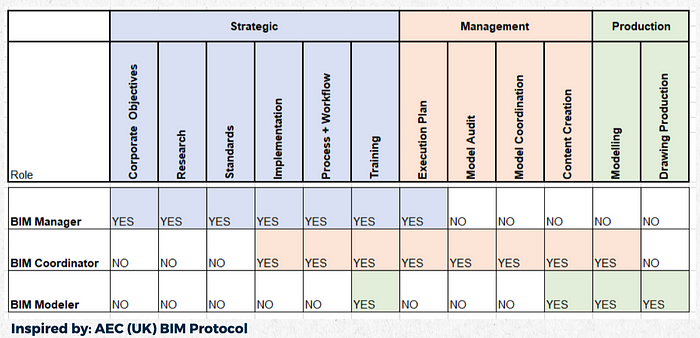
The table highlights three key roles: BIM Manager, BIM Coordinator, and BIM Modeler.
Let’s delve into each one:
BIM Modeler
Starting with the BIM Modeler role. According to the table, the primary responsibility of this position is creating families, and to a lesser extent, training colleagues. Frankly, I completely disagree with this distribution of duties, and I question the necessity of assigning a separate role solely for this purpose.
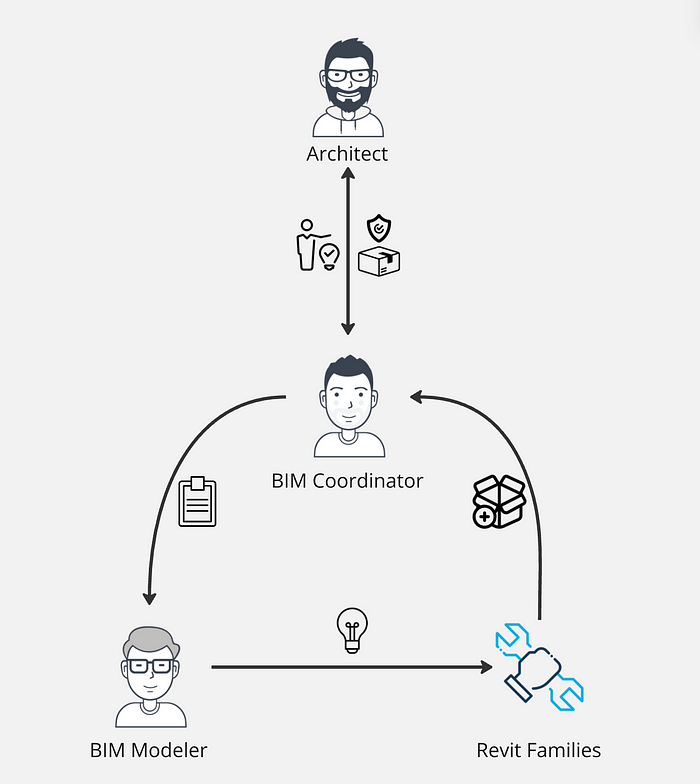
My perspective is based on the following points:
- Creating families disconnected from project needs, or conversely, designing them solely for a specific project, leads to content that doesn’t adapt well to future tasks.
- According to the table, the BIM Modeler neither coordinates the model nor fully understands the actual needs of designers when it comes to families.
In my team, BIM Coordinators handle both the creation of families and project coordination. They have a better grasp of current tasks and the standards required by different clients. This approach shortens the decision-making process, as the coordinator is both the decision-maker and the implementer. This allows them to:
- Create families that comply with standards and requirements,
- Simplify families to an acceptable level, avoiding issues with overmodeling and overdetailing,
- Provide designers with exactly what they need in the shortest possible time.
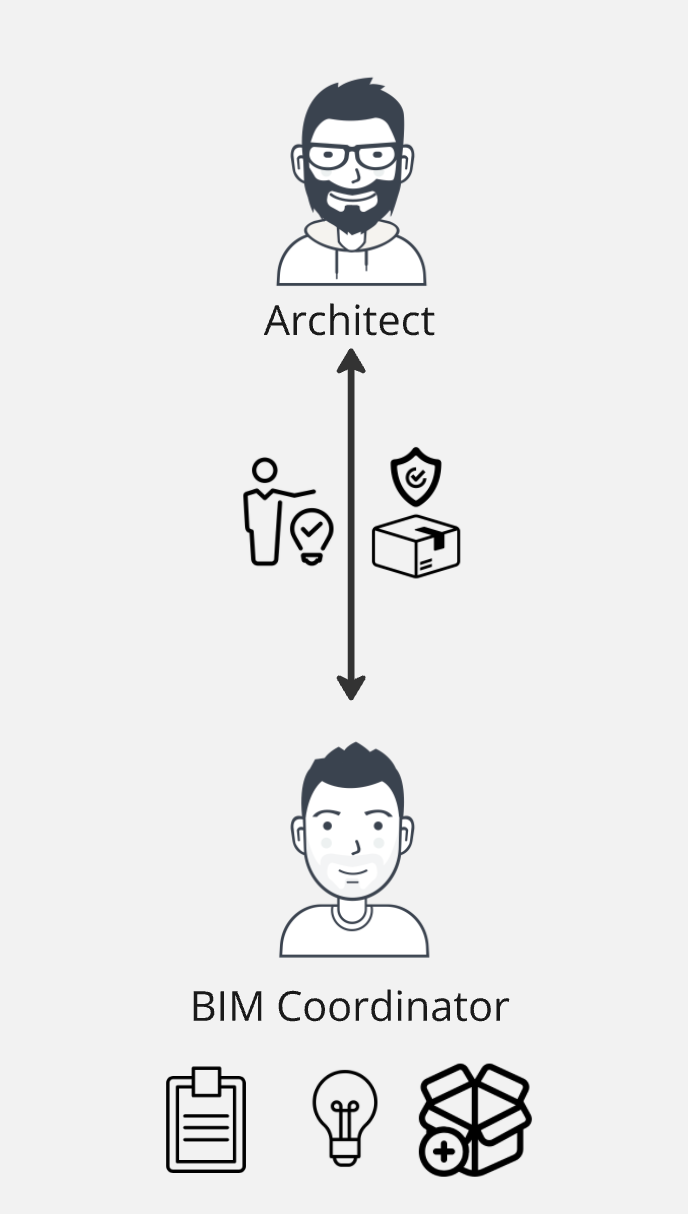
Conclusion: The role of a BIM Modeler is appropriate only in environments where design operates like an assembly line. In other cases, their responsibilities can be distributed among other specialists — assuming, of course, that the BIM Coordinator isn’t overloaded with projects.
P.S. Moreover, the term “BIM Modeler” is often closely associated with Revit. But as we know, BIM isn’t limited to just Revit.
BIM Coordinator
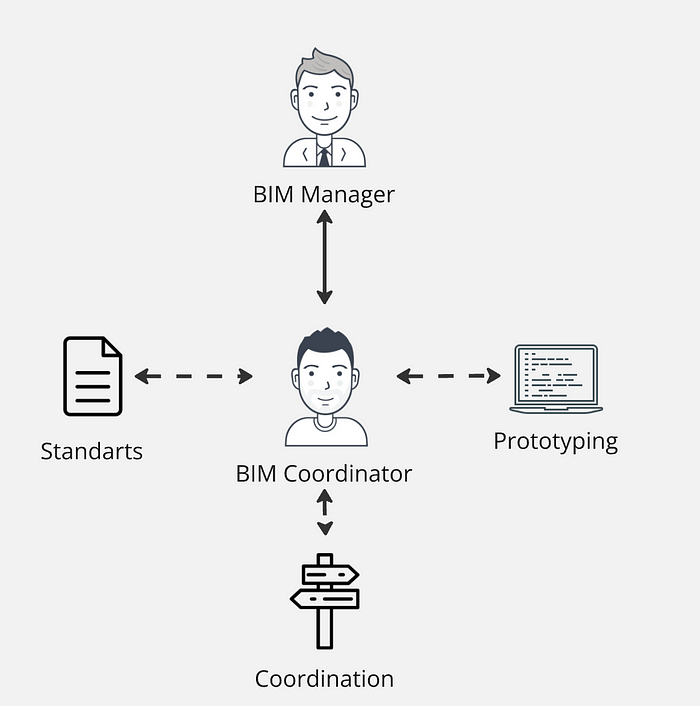
The BIM Coordinator is the key player in any BIM department. Here, I almost entirely agree with the description provided in the table.
This professional is a true “Swiss Army knife.” They need to be proficient in everything — from modeling to coordination. In my practice, I even allow coordinators to engage in development: if they create a working prototype, they’re given the opportunity to refine it during work hours.
In all other aspects, what’s listed in the table aligns with my vision.
BIM Manager
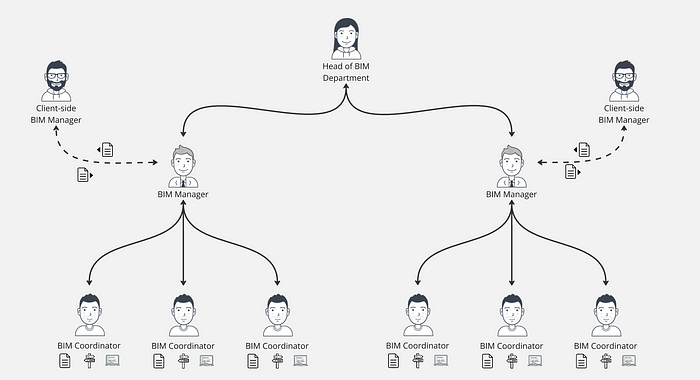
The BIM Manager is a manager in the broadest sense of the term. Their main responsibilities are:
- Coordinating the work of BIM Coordinators. The manager redistributes resources among projects, responding to changes — accelerating progress where needed or temporarily pausing development elsewhere.
- Ensuring compliance with project requirements. Occasionally, the manager participates in project audits to verify that everything is being executed correctly.
- Data Management. Managers are responsible for quantification: they review and submit data to the client. This is crucial because the client’s financial models are based on these figures, and errors are unacceptable.
Direct interaction between the BIM Manager and clients is minimal. They primarily liaise with the client’s operational staff to resolve day-to-day issues.
IT Department
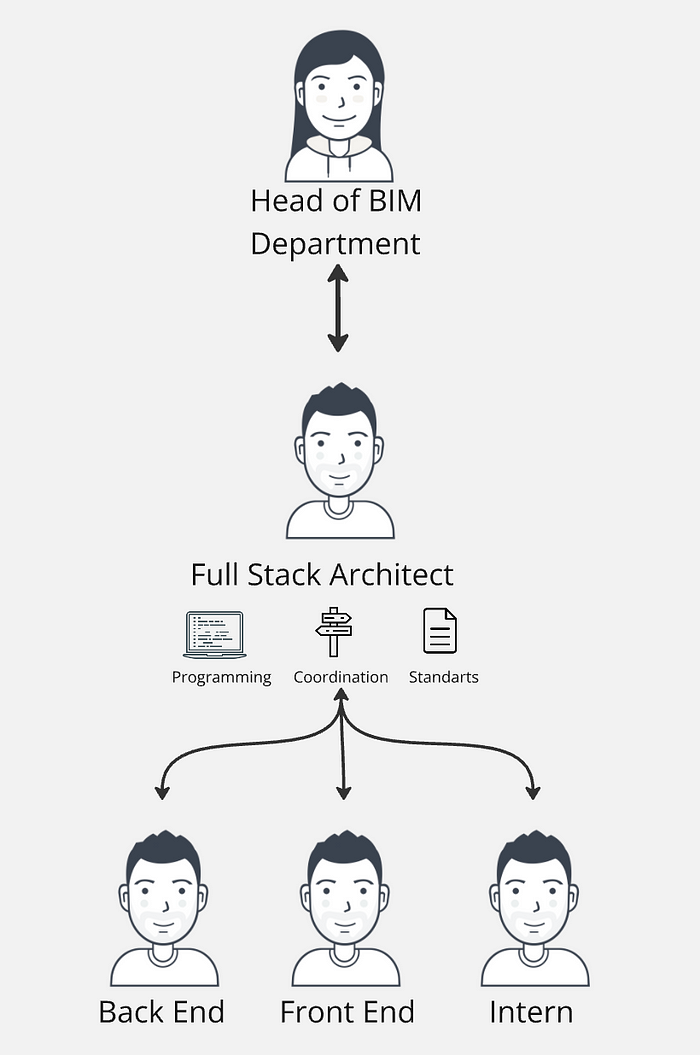
As you may have noticed, I haven’t mentioned scripts and plugins in the context of BIM specialists. That’s because we have a separate IT department dedicated to development.
The IT Department reports directly to me as the head of the BIM department. The team includes:
- A lead developer (who oversees the others),
- Backend developers,
- Frontend developers,
- Interns who assist in easing the workload of the main specialists.
The IT department focuses exclusively on development. This specialization allows us to produce high-quality code quickly without being sidetracked by other tasks.
BIM Intern
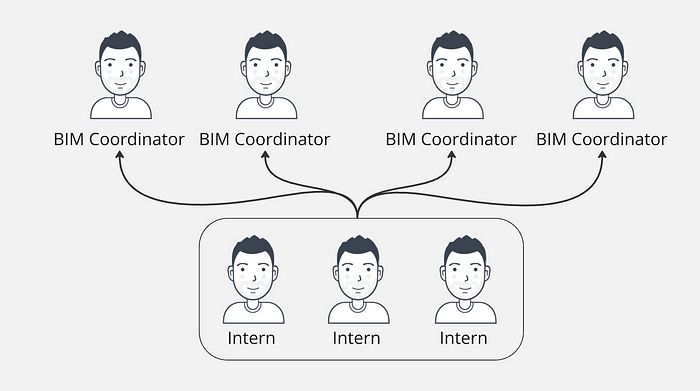
This role emerged relatively recently as a response to the challenge of finding experienced specialists. We decided to “cultivate” our own talent.
We bring in students and train them in the fundamentals of BIM. Within a year, an intern can develop into a competent BIM Coordinator.
Initially, interns handle simple tasks:
- Exporting models,
- Data cleaning,
- Checking visual clashes (those that can’t be detected automatically),
- Compiling reports.
This approach alleviates the workload of our coordinators, while providing interns with real-world experience and paid employment.
Head of the BIM Department
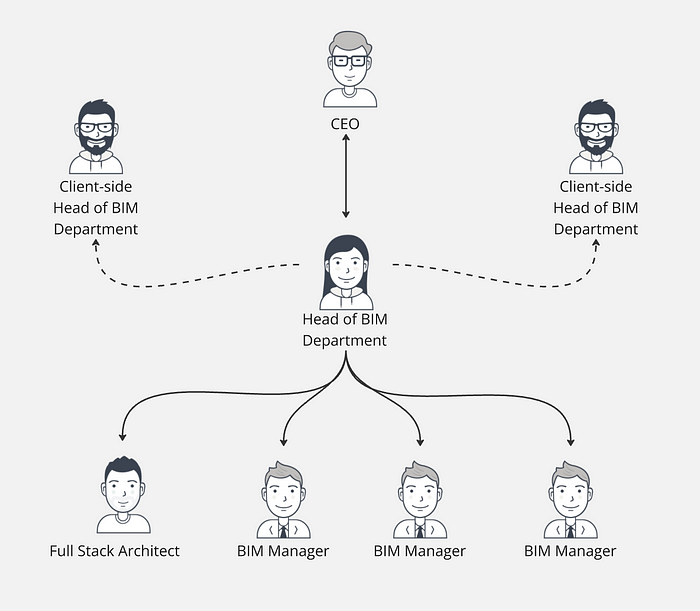
Now, about my role.
My responsibilities include:
- Overseeing the work of BIM Managers, the IT department, and coordinating with other project leaders.
- Establishing communication mechanisms to ensure all information is delivered promptly.
- Negotiating with clients and contractors.
- Strategic development of the company: selecting software, adapting standards to meet client requirements and government regulations.
Occasionally, I have to develop software prototypes (MVPs). I create a basic prototype, present it to the IT department, and they turn it into a full-fledged solution.
What the Structure Looks Like in the End
As a result, my structure differs somewhat. Here’s a revised table of roles and responsibilities based on my experience:
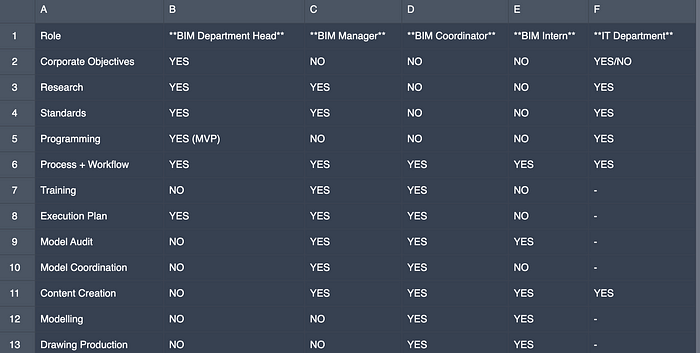
Conclusion
In our operational model, we utilize a hierarchical-matrix BIM management structure, where roles are clearly defined across different levels but remain interconnected. This balance allows each team member to take responsibility for their specific area while engaging with broader processes when necessary. Such an approach enables us to effectively handle current tasks while simultaneously developing strategic initiatives, including setting standards, creating tools, and training personnel.
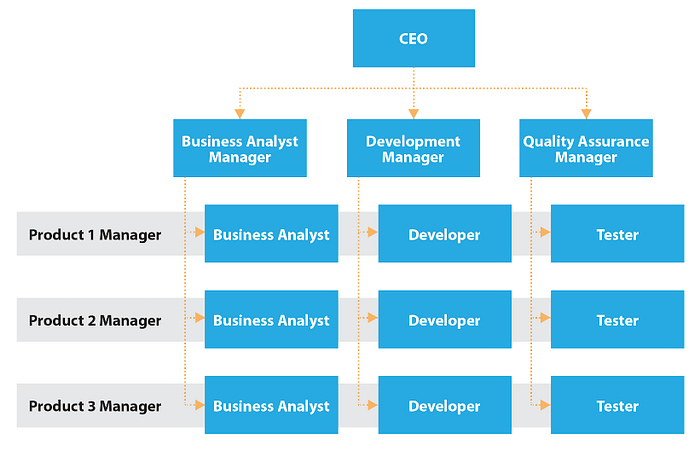
Final Thoughts
To echo the words of Ignacy Lozinski, roles and their responsibilities can vary significantly from one company to another, and that’s perfectly normal. I just wanted to share how this division is implemented in my organization and to offer some of my thoughts. Perhaps it’s somewhat superficial, but I believe it’s illustrative enough.
Question for you: Does your company have any unique roles, and what responsibilities do they carry? For example, in my company, the position of “Intern” is called “Junior BIM Specialist Assistant.”




